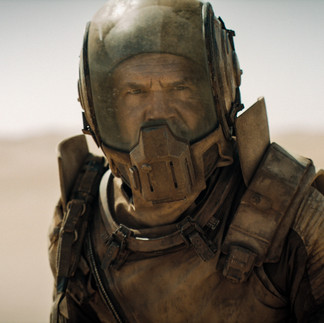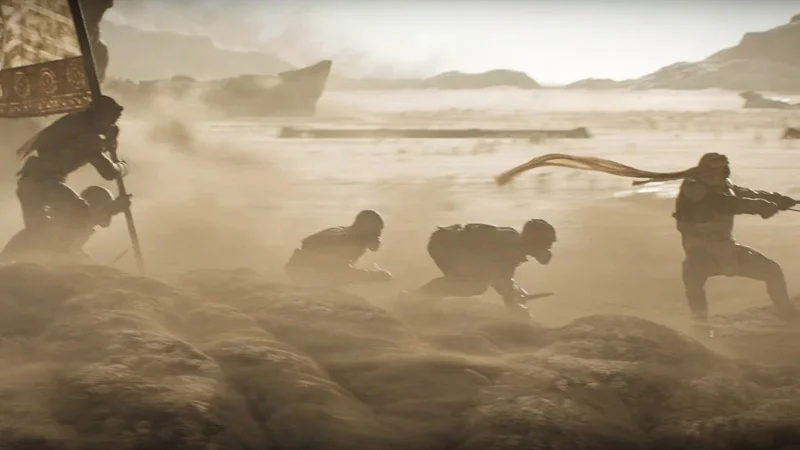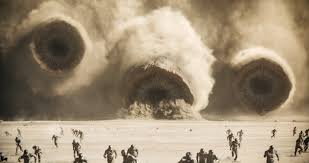Dune (Part Two):”Spice is power”
- eclectic Stefan

- Mar 7, 2024
- 4 min read

The desolate dunes of Arrakis, the giant sandworms that excrete the mind-altering spice melange, the warring Houses of Atreides and Harkonnen and the indigenous inhabitants of Arrakis, the Fremen, return in the second part of Denis Villeneuve’s adaptation of Frank Herbert’s book, Dune. Dune (Part Two) continues the cinematic sweep of the vast story of planetary dynasties and their domination of the production of the most powerful spice melange.
Dune (Part One) interwove the stories, political intrigues and characterisations fluidly . I was effusive about the first part of Dune but am underwhelmed about Dune (Part 2). It continues the cycle of Dune and opens it to the next instalment. Two-thirds of Dune (Part Two) requires extensive dialogue that explains what is happening and people’s conniving intentions from the brutal, ruthless, sadistic Harkonnens to the determined, fatalistic, blue-eyed Fremen, whereas Dune(Part One) interwove the threads to build an understanding of all the players and elements in the Dune universe. We were immersed with the sandworms, Shai-Hulud; the family dynasties; the rebels who fight to turn arid Arrakis into a green paradise and the mystical Bene Gesserit. Sadly, the wonderfully depicted Spice Navigators have gone missing in action in Dune (Part Two).
Bene Gesserit, spice mining & the sociopathic Feyd-Rautha Harkonnen
The second film presents each story in clear-cut segments that eventually collide in the final third of the film. I felt as if I was watching a movie about the House of Harkonnen then switched to a story about the Fremen and their fight to establish a green paradise on Arrakis then to the story about the prophecy about Paul Atreides. The stories are compartmentalised rather than integrated. The only thread that wanders through the segments is the prophecy about a Dune Messiah, who the Bene Gesserit manipulate and the Fremen believe will be Paul Atreides, their terraforming saviour. The warring Houses aren’t happy about that because that would mean the loss of the by-product of the sandworms, the spice melange, and the wealth it delivers to the Houses and the Emperor who controls the Houses.
And there are parts of the movie that seem to be missing, such as a key segment where Paul is sent to the vast loneliness of the desert dunes to discover if he can truly commune with the desert and the Shai-Hulud (sandworms). We see him enter the dunes alone but in the very next scene he has returned and successfully endured whatever encounters he experienced without us seeing it. Seeing what he endured is a critical part of his destiny as the messiah of Dune. It is more a case of telling us about the storyline rather than showing us. Perhaps it was filmed but cut from the movie due to its length. We shall never know.
Instead, we listen to the constant pronouncements by various people that almost anything Paul Atreides does and happens around him is a sign of the prophecy coming true. The dialogue surrounding the prophecy and Paul as a prophet becomes like the sentiments expressed in a greeting card. It is a case of a self-fulfilling prohecy.
Riding Shai-Hulud, the sandworms of Dune
Dune, Parts One and Two are shrouded in elements of mysticism and religiosity, including Paul as the Dune Messiah, the religious cult the Bene Gesserit, Paul’s wanderings in the desert, and the holy wars promised at the conclusion of the second movie. Even the sandworms, the Shai-Hulud are icons of faith. Sandworm surfing (have sandworm, will travel) is a dynamically depicted highlight of the final third of the movie.
Dune (Part Two) doesn’t fail to impress with its design , costumes, sound, characters, romance, and power that gives gives birth to treachery. In so many ways, the second film has the hallmarks of the first in its operatic intergalactic scope, yet it settles into a monotony of pace and rhythm interspersed with spectacular battles and barbaric acts of cruelty. It’s curious that the peaks and troughs of action and exposition appear remarkedly flat and homogenised.
The battle for the prophet & the prophecy of Paul Atreides, Dune Messiah
Part Two is all tied together by the movie's conclusion and provides an ending that will lead into the next chapter of Frank Herbert’s Dune saga. It fulfils the prophecy, satisfies Dune fanatics and even provides surprises regarding Paul’s lineage but really becomes another Hollywood blockbuster spectacle in tone and nature that prepares us for an extended franchise of Dune movies. Herbert wrote six books in the Dune mythology—Dune, Dune Messiah, Children of Dune, God Emperor of Dune, Heretics of Dune, Chapterhouse: Dune—that will provide fodder for the Dune story for years to come. That would be a pity because that would make it grist for the Hollywood mill. A Dune franchise will diminish Villeneuve’s achievement.
Official Trailer Dune (Part Two)
Video & photos © Warner Brothers & Legendary
For any Dune devotee, Dune (Part Two) is worth seeing but unnecessary and incoherent if you haven’t seen Dune (Part One). Even the spice melange will not help you navigate your way through the miscellany of characters, conflicts and thematic concerns.
I was effusive about the first movie but underwhelmed by the second movie, despite its high production values, and am not enthused about further sequels.
After two movies, it already seems committed and condemned to an cycle of Dune franchise movies and feels like it will descend into the complacency that exhausted the original Star Wars trilogy to a lacklustre shadow of the original concept.
FILM EXTRAS: DUNE (PART ONE)

Dune (Part One)
Released 2021
Paul Atreides, a young man born into a great destiny beyond his understanding, must travel to the most dangerous planet in the universe to ensure the future of his family and his people, while malevolent forces explode into conflict over the planet's exclusive supply of the most precious resource in existence.














